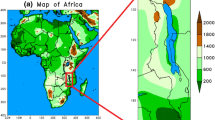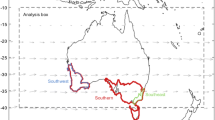Abstract
One of the aims of developing new climate projections is to better address the requirements of stakeholders—particularly those who require less uncertainty and/or probabilistic information to work with. Projections are continually updated over time as more, and newer, climate model simulations of the future become available but this can introduce problems when it comes to interpreting large samples with differing results. Regional projections of rainfall are characterised by a high level of uncertainty, partly because of different sensitivities of the different models. Some models can be demonstrated to perform relatively poorly when assessed by their ability to simulate present-day means and variability and here we show that the uncertainty in model projections can potentially be reduced when the projection from these models are either discounted or ignored entirely. When applied to the Murray Darling Basin of south east Australia, it is possible to demonstrate a clustering of the results from the better performing models. These indicate that the rainfall changes to be expected as a result of increased greenhouse gas concentrations into the future are more likely to be at the drier end of the full set of model results. This occurs because the better performing models indicate decreases in winter and spring which are significantly different to the changes indicated by the other models. These results suggest that there are compelling reasons for discounting, if not entirely dismissing, some model results based on their failure to satisfy some basic performance criteria.
Similar content being viewed by others
References
Brekke LD, Dettinger MD, Maurer EP, Anderson M (2008) Significance of model credibility in estimating climate projection distributions for regional hydroclimatological risk assessments. Clim Change 89:371–394
Charles SP, Bari M, Kitsios A, Bates BC (2007) Effect of GCM bias on downscaled precipitation and runoff projections for the Serpentine catchment, Western Australia. Int J Climatol 27:1673–1690
CSIRO and Bureau of Meteorology (2007) Climate change in Australia. Technical report, 140 pp
Giorgi F, Mearns LO (2002) Calculation of average, uncertainty range, and reliability of regional climate changes from AOGCM simulations via the “Reliability Ensemble Averaging” (REA) method. J Clim 15(10):1141–1158
Giorgi F, Mearns LO (2003) Probability of regional climate change based on the Reliability Ensemble Averaging (REA) method. Geophys Res Lett 30(12):1629. doi:10.1029/2003GL017130
Guilyardi E, Gualdi S, Slingo J, Navarra A, Delecluse P et al (2004) Representing El Nino in coupled ocean–atmosphere GCMs: The dominant role of the atmosphere component. J Clim 17:4623–4629
Jun M, Knutti R, Nychka DW (2008) Spatial analysis to quantify numerical model bias and dependence: how many climate models are there? J Am Stat Assoc 103(483):934–947. doi:10.1198/016214507000001265
Maximo CC, McAvaney BJ, Pitman AJ, Perkins SE (2007) Ranking the AR4 climate models over the Murray-Darling Basin using simulated maximum temperature, minimum temperature and precipitation. In J Climatol 28:1097–1112. doi:10.1002/joc.1612
Min S-K, Legutke S, Hense A, Kwon W-T (2005) Internal variability in a 1000-yr control simulation with the coupled climate model ECHO-G - II. El Niño Southern oscillation and North Atlantic oscillation. Tellus A 57(4):622–640
Perkins SE, Pitman AJ, Holbrook NJ, McAveney J (2007) Evaluation of the AR4 climate models’ simulated daily maximum temperature, minimum temperature and precipitation over Australia using probability density functions. J Clim 20:4356–4376
Preston BL, Jones RN (2008) Evaluating sources of uncertainty in Australian runoff projections. AdvWater Resour 31:758–775
Rahmstorf S, Cazenave A, Church JA, Hansen JE, Keeling RF, Parker DE, Somerville RCJ (2007) Recent climate observations compared to projections. Science 316:709
Raisanen J (2007) How reliable are climate models? Tellus 59A:2–29
Raupach MR, Philippe Ciais GM, Le Quérél C, Canadell JG, Klepper G, Field CB (2007) Global and regional drivers of accelerating CO2 emissions. PNAS 104(24):10288–10293
Reichler T, Kim J (2008) How well do coupled models simulate today’s climate? Bull Am Meteorol Soc 89(3):303–311
Roe GH, Baker MB (2007) Why is climate sensitivity so unpredictable? Science 318(5850):629–632
Stainforth DA, Allen MR, Tredger ER, Smith LA (2007) Confidence, uncertainty and decision-support relevance in climate predictions. Phil Trans R Soc A 365:2145–2161
Suppiah R, Hennessy KJ, Whetton PH, McInnes K, Macadam I, Bathols J, Ricketts J, Page CM (2007) Australian climate change projections derived from simulations performed for the IPCC 4th Assessment Report. Aust Meteorol Mag 56:131–152
Tebaldi C, Knutti R (2007) The use of the multi-model ensemble in probabilistic climate projections. Phil Trans R Soc A 365:2053–2075
van Oldenborgh GJ, Philip YS, Collins M (2005) El-Nino in a changing climate: a multi-model study. Ocean Sci 1:81–95
Walsh JE, Chapman WL, Romanovsky V, Christensen JH, Stendel M (2008) Global climate model performance over Alaska and Greenland. J Clim 21:6156–6174
Watterson IG (1996) Non-dimensional measures of climate model performance. Int J Climatol 16:379–391
Watterson IG (2008) Calculation of probability density functions for temperature and precipitation change under global warming. J Geophys Res 113:D12106. doi:10.1029/2007JD009254
Whetton P, Macadam I, Bathols J, O’Grady J (2007) Assessment of the use of current climate patterns to evaluate regional enhanced greenhouse response pattern of climate models. Geophys Res Lett 34:L14701. doi:10.1029/2007GL030025
Author information
Authors and Affiliations
Corresponding author
Rights and permissions
About this article
Cite this article
Smith, I., Chandler, E. Refining rainfall projections for the Murray Darling Basin of south-east Australia—the effect of sampling model results based on performance. Climatic Change 102, 377–393 (2010). https://doi.org/10.1007/s10584-009-9757-1
Received:
Accepted:
Published:
Issue Date:
DOI: https://doi.org/10.1007/s10584-009-9757-1




